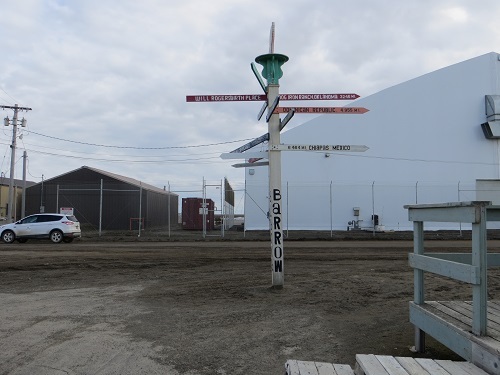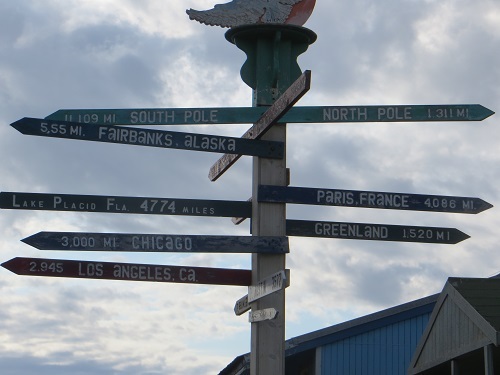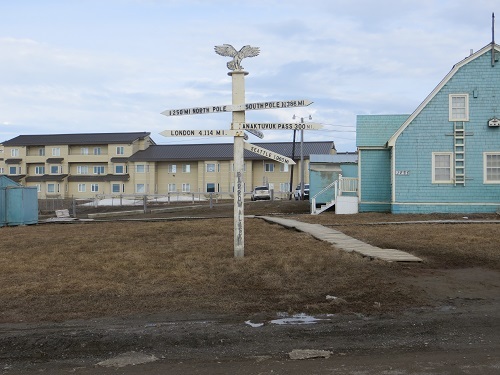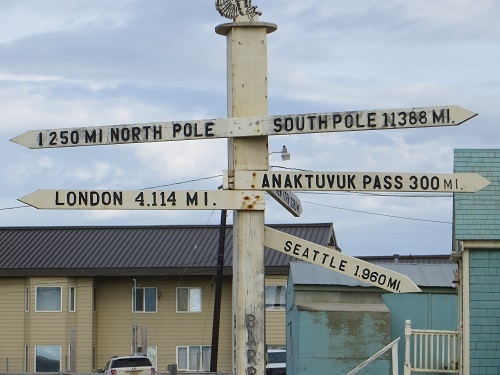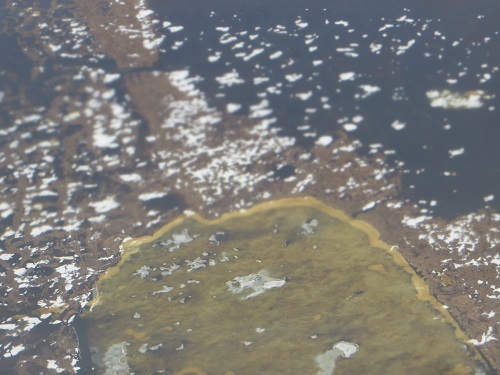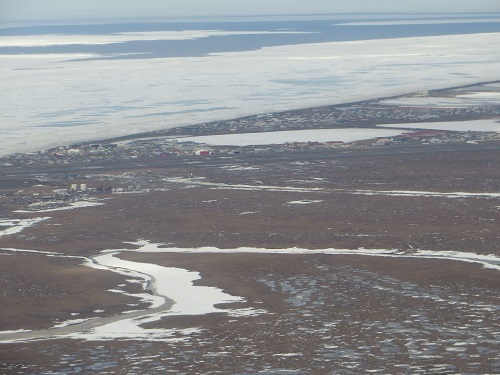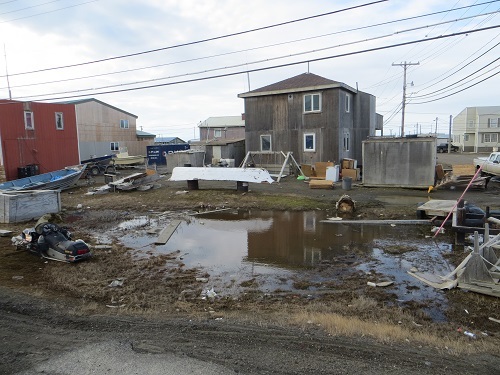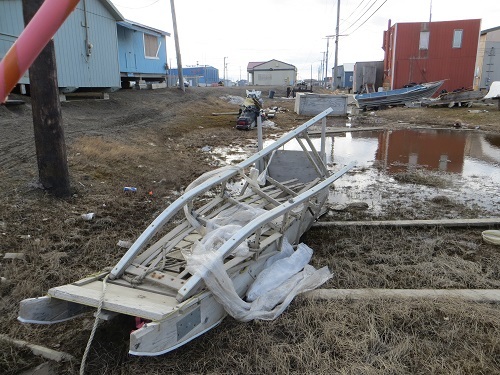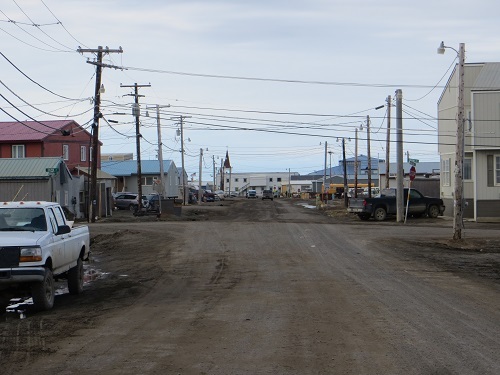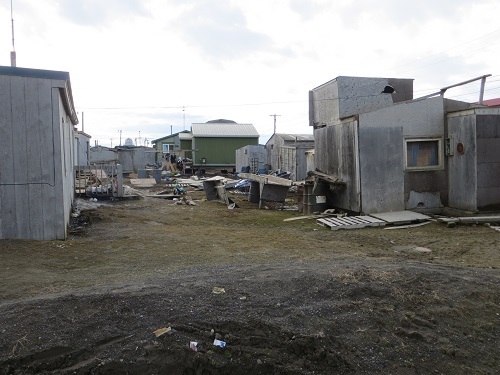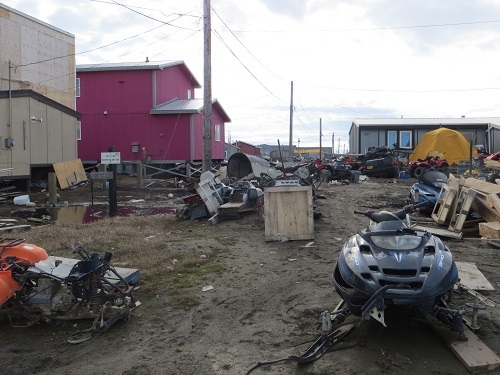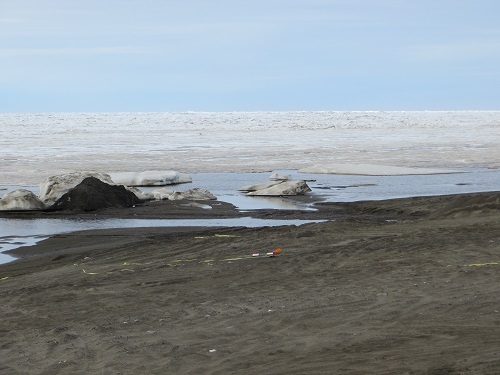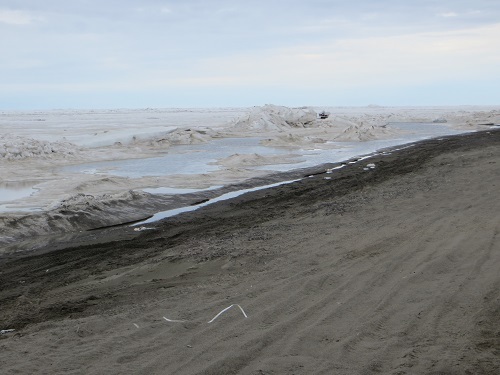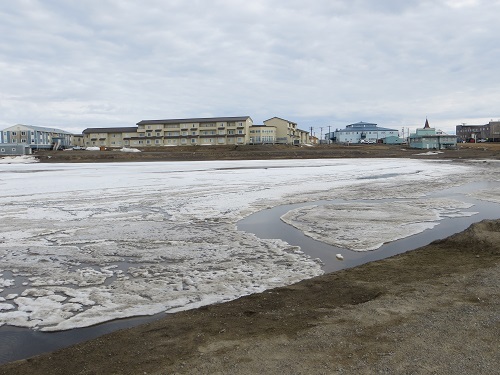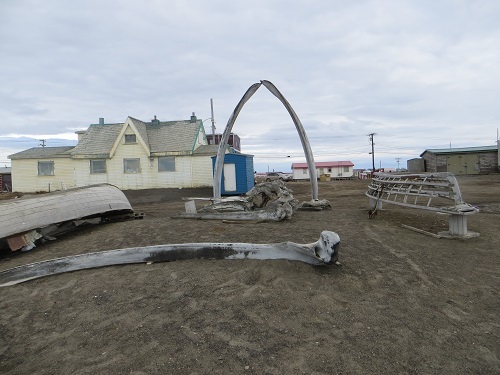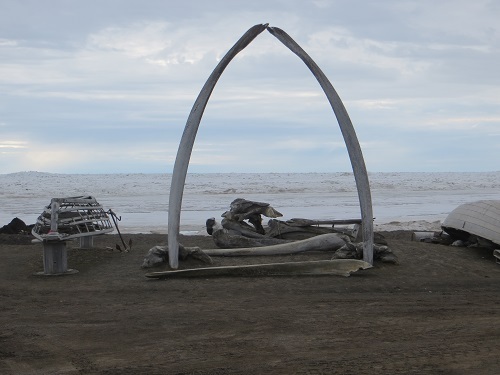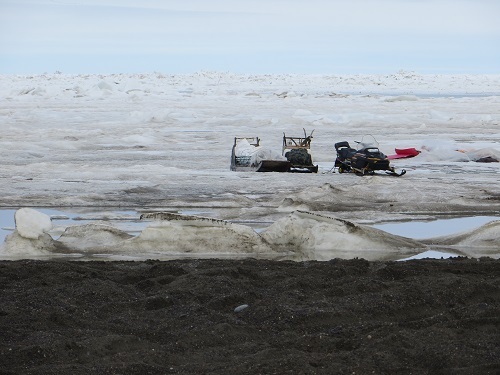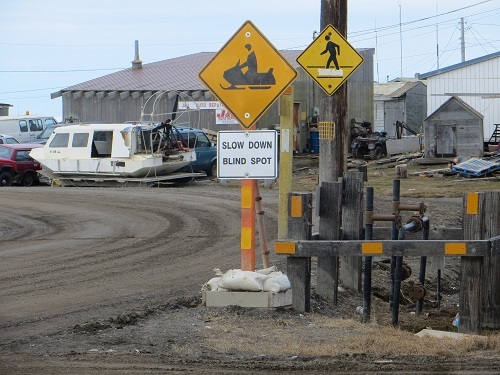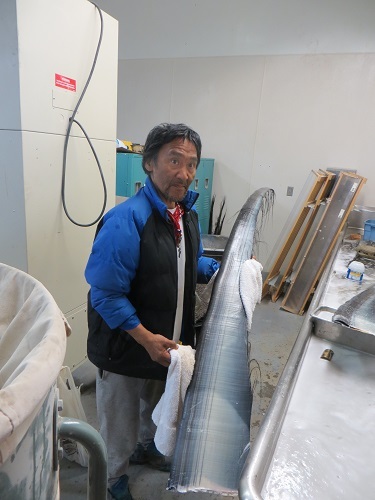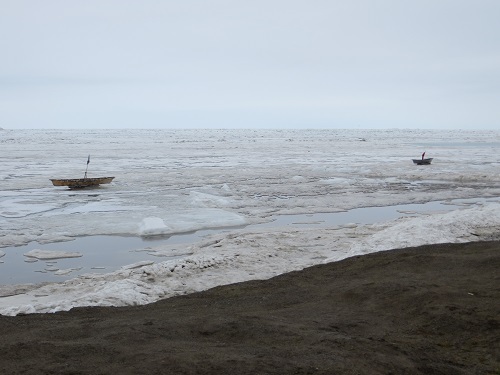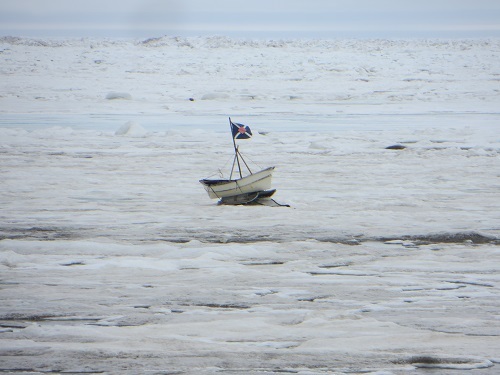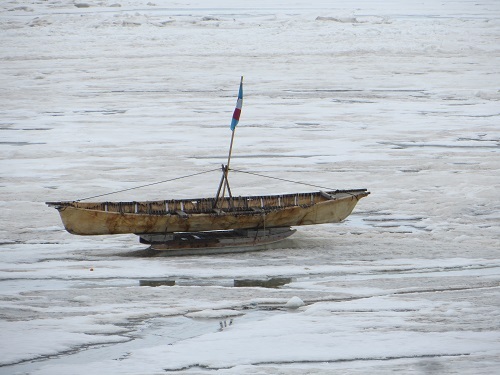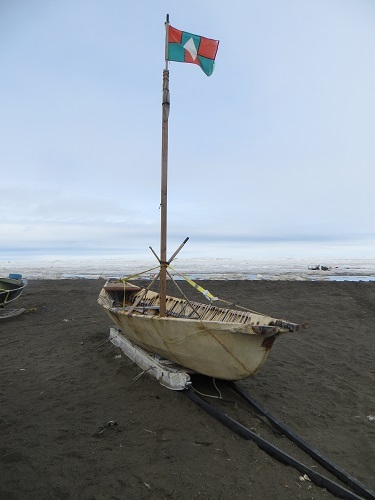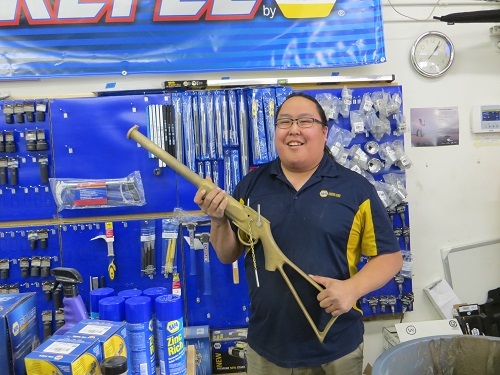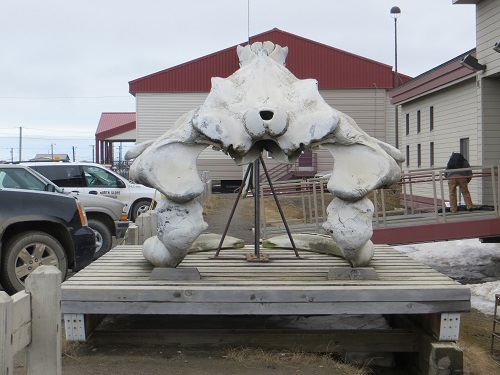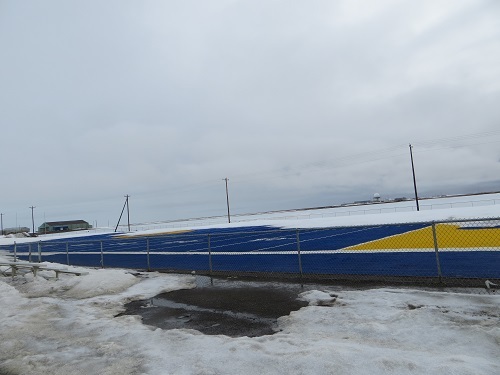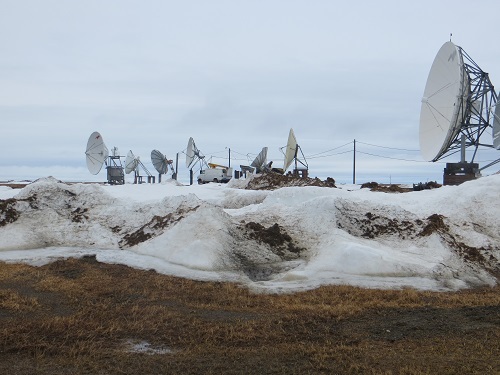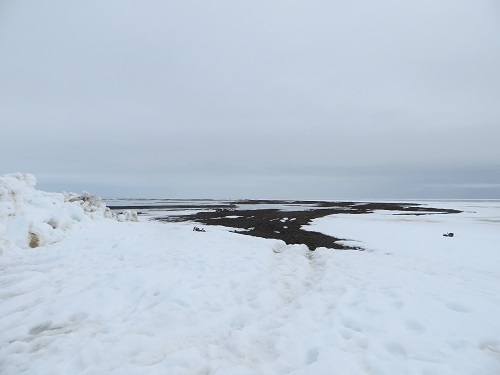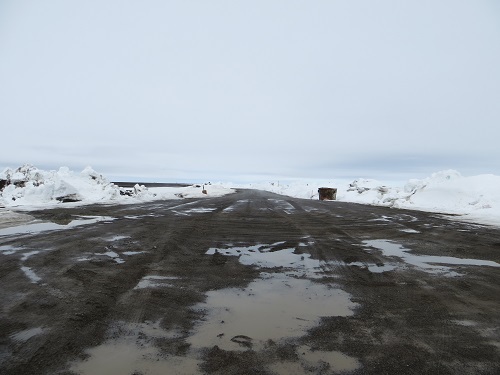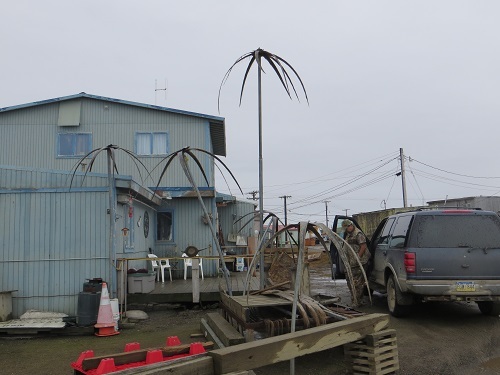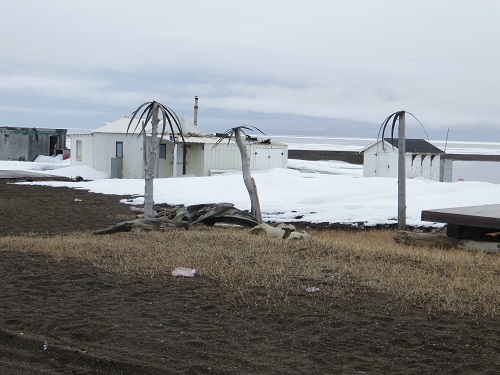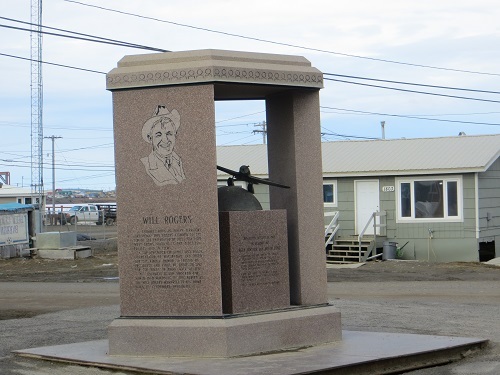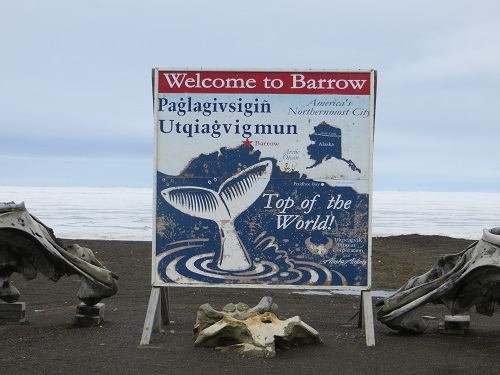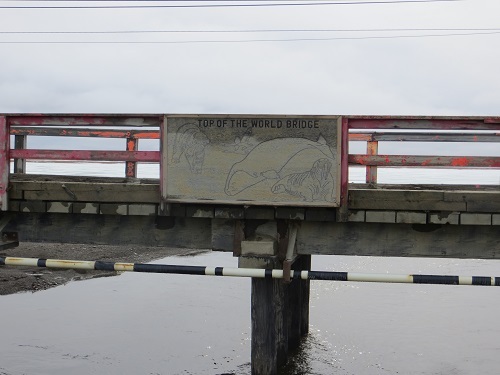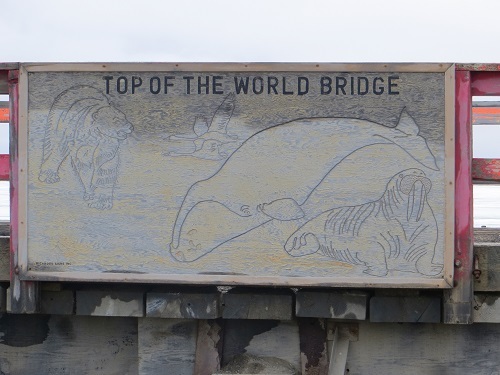Barrow, the northernmost town in the United States, 350 miles north of the Arctic Circle, is a bit of a mess. It can't even make up its mind how far it actually is from the North Pole, let alone from its southern counterpoint.
A multi-destination signpost just outside the airport proclaims it 1,311 miles south of the North Pole and 11,109 miles north of the South Pole.
Barely a couple of hundred yards' walk further north, but apparently closer to God since it's just by a church, another multi-destination sign post announces: North Pole 1250, South Pole 11,388. Sixty-one miles in five minutes! Talk about Godspeed!
A check on the internet gives yer another: North Pole 1,298 miles, South Pole 11,132 miles. I give up. I'm not gonna walk it, anyway.
The view of the terrain from Deadhorse to Barrow, though, aboard Alaska Airline's Boeing 737-400 Combi, a combined cargo and passenger plane, is fascinating - a crazy quilt of flat, brownish, treeless tundra, bright white ice, glints of iridescent blue, the brilliant yellow-green of lichen, and pipelines and service roads forming the irregular blocks of a giant geological jigsaw puzzle.
In late May, Barrow's roads are mud and gravel filled with puddles as the spring melt sets in. Its raggedy mainly wooden buildings are built on stilts to prevent them sinking and collapsing over because of the continual melting and refreezing of the permafrost.
The houses' yards are filled with everything from skin boats and upturned sleds to bits of whale blubber, drying seal skins and battered ATV quads.
In fact everybody seems to be buzzing merrily all over the place on ATVs, especially along the gravelly waterfront by the Chukchi Sea, part of the Arctic Ocean way north of the Bering Strait. Huge blocks of jagged ice lay packed against the gravelly shore, driven there by the region's famously ferocious winds. As we speak, a gent is bouncing along on the pack ice on a skidoo.
As capital of North Slope Borough, at 95,000 square miles the largest U.S. county-level division, and larger than the whole of the United Kingdom, Barrow is home to about half of the region's 9,000 inhabitants.
Some 60 percent are indigenous or mixed-blood Iñupiat Inuit, and the rest are a vast amalgam ranging from Caucasian whites and African Americans to Koreans, Chinese, West Indians, Filipinos, Saudis, Samoans and Tongans, 38 nationalities in all, drawn here by the high wages offered either by the local government, the main employer, or the local oil and gas service industries.
In fact, of 10 restaurants here, seven are run Koreans, one by a Mexican and two by a Serbian.
A millennium and a half before British naval geographer Frederick William Beechey named the area after Sir John Barrow, Second Secretary to the Admiralty, and centuries before whalers from New Bedford flocked to its whale-rich waters, the Iñupiat inhabited these barren shores, calling it Ukpeagvik, 'place where snowy owls are hunted.'
They hunted whales in total sustainability before the whaling onslaught from down south, taking just what they needed, meat and blubber for food, oil for fire and light, skin for clothes and other uses, bones and baleen for tools and art.
Today they continue this major ingredient of their traditional heritage, allowed to harvest 24 mainly bowhead whales a year despite the moratoria for other would-be whalers.
A few 18-foot long seal hide-covered craft are drawn up on the pack ice or nearby gravel, flying their family flags, the equivalent of a crest of arms, showing that they've recently caught a whale. They still use seal skins skillfully sewn together by the women and drawn tight over wooden frames to waterproof the craft - rather than aluminium whose rivets would pop in the ice and freezing water.
Except from July to September there's always shore ice. The Iñupiat drag the craft over the ice to the open water and sea channels, anything from two to 10 miles from shore. They still fire harpoons into the massive animals, but no longer as a means to kill it, only to mark its location.
They then fire a whale bomb from a heavy rifle - a pointed brass tube filled with explosives and a delayed fuse so that it will detonate after burying itself deep in the whale's centre, the shrapnel destroying the heart or other vital organs. If it exploded on the body's surface it would do little damage.
The guns and whale bombs are on sale at the town's auto parts outlet.
A bowhead whale skull is on show outside the Iñupiat cultural centre. It's 17 feet long, a third of the creature's total length. The animal weighed a ton for each foot in length, totalling 51 tons. Last night one family celebrated its latest catch, hosting a blubber-eating party for all comers.
One of the oddities of Barrow is the result of the hard work and arguably good heart of a Florida lady named Cathy Parker. In a place where the temperature only climbs above freezing 100 days a year, she felt it was unfair that the high school kids had to play football indoors.
So she helped raise $500,000, plus another $500,000 for installation, for her version of a field of dreams, a beautiful deep blue full-sized astroturf - used four times a year for inter-state games. Perhaps the money could have been put to better use, but prices, fuelled by the North Slope oil bonanza, are astronomical - $550,000 to buy a rundown little three-bedroom hovel.
Because the school superintendent's son wanted to play football so badly, he managed to sell the idea to the board. That's a helluva lot of money for a game, but the town's residents, especially those from the Caribbean and the South Pacific, are delighted. They have somewhere decent to play pickup soccer.
Another oddity here caused by Earth's sharp curvature so far north is the direction of the many large satellite dishes. They're all virtually horizontal as most satellites orbit the equator and the dishes now point along the plane and no longer have to point vertically up in the air.
The curvature is so sharp and the horizons so close that the last time the sun rose and set was over two weeks ago on May 11, when it rose at 2.54 A.M. and set the following day at 1.53 A.M. Now it's full daylight 24 hours a day, no sunrise, no sunset, just the golden orb going round the heavens.
It won't set again until 2.10 A.M. on August 2, rising again 48 minutes later at 2.58 A.M. But by November 18 it'll rise for the last time this year at 12.34 P.M., set an hour and 15 minutes later at 1.49 P.M., and then stay down until January 23, when it'll rise once more at 1.10 P.M., only to pop back down again 58 minutes later at 2.08 P.M.
Point Barrow, some nine miles northeast of Barrow, is the northernmost point of the U.S. and arguably the reason why many tourists, of whom there are several thousand a year, come here. It's a dirty grey-brownish strand of gravel poking out into the frozen depths of the Arctic Ocean.
On the left is the Chukchi Sea, on the right the Beaufort Sea - and straight ahead, if you're lucky, a polar bear, lucky that is if you're in Mike Shults' van. Unlucky if it thinks you're food and you're on foot.
Today there are no polar bears on the horizon, but Mike, an implant from Seattle and an excellent guide who has been here 41 years, has promised to phone me if he hears of one wandering around and to drive me out to see it free of charge.
He's decorated his house with 'Arctic palm trees,' poles with bits of whale baleen fixed on top like fronds.
Meanwhile I'm wandering around town dodging ATVs and awaiting the Call of the Wild - Mike's sighting of Mr. or Mrs. Polar Bear.
There's a big tent-like building for ice hockey and curling, there's Arctic Pizza owned by Koreans, there's petrol at $7 a gallon, ironical in an oil region but it has to go south to be refined.
And there's the Wiley Post-Will Rogers Memorial, the two gents after whom the airport is also named. Rogers, the legendary part-Cherokee cowboy, performer, social commentator, film actor and wit, and Post, the first solo pilot to fly around the world, died when their plane crashed into a lagoon at Point Barrow in 1935.
Meanwhile, it's gone 9 P.M. and I've heard no further word from Mike or the polar bears.
P.S. Now midnight, nice and bright, not a Mike nor a polar bear in sight.
[Upcoming blog on Thursday: Alaska's scenic Homer and the amazing sea otters]
______________
By the same author: Bussing The Amazon: On The Road With The Accidental Journalist, available with free excerpts on Kindle and in print version on Amazon.
Swimming With Fidel: The Toils Of An Accidental Journalist, available on Kindle, with free excerpts here, and in print version on Amazon in the U.S here.
